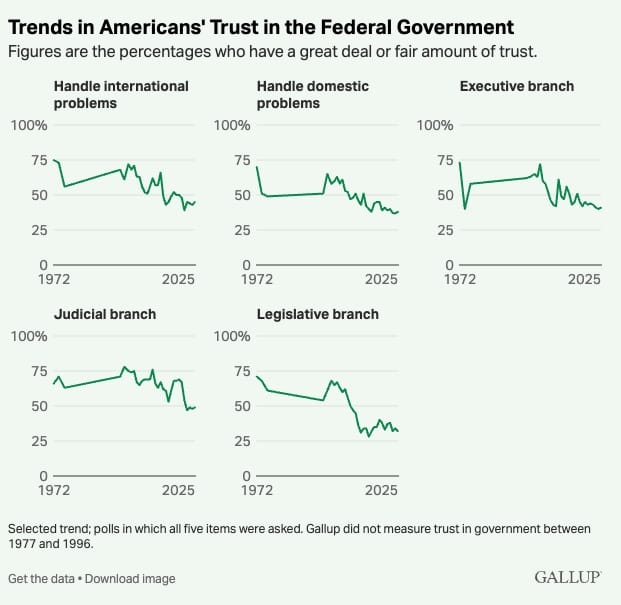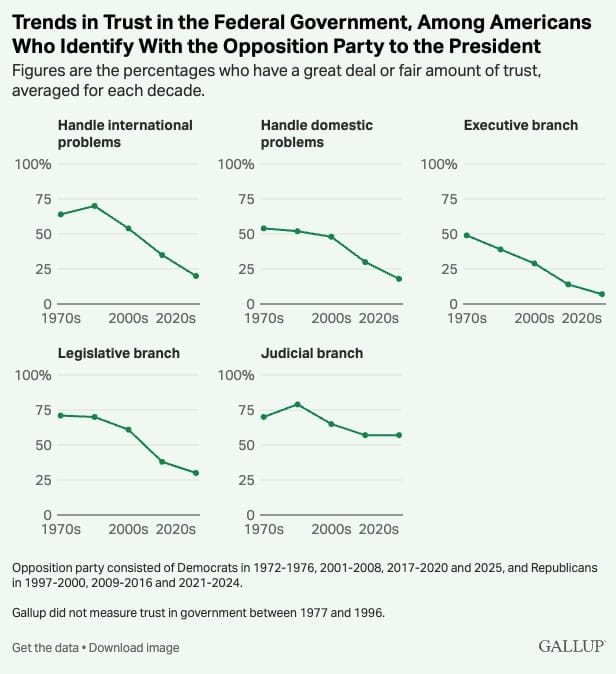Top 5 US news stories
November 11 2025

Trust in All Three Branches of US Government Nears Five-Decade Low
Senate Passes Bill to End Longest Government Shutdown; Measure Moves to House
US, China Escalate 'AI Cold War' as Beijing Ramps Up State-Led Tech Push
GLP-1 Makers Cut Prices in Strategic Bid to Secure Millions of Medicare Patients
Beijing to Create 'Validated End-User' System for Rare Earths, Blocking US Military Access
…US GOVERNMENT SHUTDOWN ENTERS 42nd DAY…
1. Trust in All Three Branches of US Government Nears Five-Decade Low

The shares of Americans who trust each of the three branches of government are near five-decade lows, as opinions of the federal government grow more polarized. Only 32% of US adults have a “great deal” or “fair amount” of trust in the legislative branch, according to new Gallup polling, while 41% say the same of the executive branch and 49% of the judicial branch. Meanwhile, 45% trust the federal government to handle international challenges, while only 38% trust the government to handle domestic issues. While on par with readings from last year, when President Joe Biden was in office, partisans’ views shifted substantially with the change in party control. Republicans’ trust in the executive branch, for instance, increased 83 percentage points this year after President Donald Trump took office, while Democrats’ trust dropped 78 points and independents’ trust ticked up three points.
Semafor

2. Senate Passes Bill to End Longest Government Shutdown; Measure Moves to House
The Senate passed legislation on Monday night to end the nation’s longest government shutdown, after a critical splinter group of Democrats joined with Republicans and backed a spending package that omitted the chief concession their party had spent weeks demanding. The 60-to-40 vote, on Day 41 of the shutdown, signaled a break in the gridlock that has shuttered the government for weeks, leaving hundreds of thousands of federal workers furloughed, millions of Americans at risk of losing food assistance and millions more facing air-travel disruptions. The measure goes next to the House, which is expected to take it up no sooner than Wednesday and where the small Republican margin of control and intense Democratic opposition could make for a close vote. President Trump has indicated that he will sign it.
NYT
3. US, China Escalate 'AI Cold War' as Beijing Ramps Up State-Led Tech Push
China’s leaders were anxious and frustrated. The world’s most promising new technology was being dominated by OpenAI, Google and other American companies. Chinese tech companies were so far behind on generative artificial intelligence early last year that many were relying on Meta Platforms’ open-source Llama models, which can be downloaded for free. Worse, U.S. restrictions on exports of top-end AI chips threatened to hobble China even further. So in the spring of 2024, Beijing ratcheted up pressure on tech executives. One leading Chinese AI company told The Wall Street Journal it fielded calls from 10 different government agencies in a single month urging action on native AI models. The country relaxed regulations, rolled out funding and rushed to install computing power. Nine months later, Chinese startup DeepSeek turned heads in Silicon Valley with a powerful new AI model. Hope began to take hold. “China finally has a model it can be proud of,” Premier Li Qiang told officials, according to people familiar with the comment. The optimism catalyzed China’s tech industry, unleashed an even bigger geyser of government support and jolted American competition into overdrive. The escalating AI race is drawing comparisons with the Cold War, and the great scientific and technological clashes that characterized it. It is likely to be at least as consequential. The contest is already helping underpin a worldwide surge in tech spending that has juiced the U.S. and Chinese stock markets and unlocked new sources of economic growth, even as it fuels fears of a global AI bubble. It is poised to transform industry, society and geopolitics. It’s pushing leaders to sideline concerns about the dangers of powerful AI models, including the spread of disinformation and other harmful content, and the development of superintelligent AI systems misaligned with human values. “The AI future is not going to be won by hand-wringing about safety,” Vice President JD Vance argued in a February speech in Paris. Both countries are driven as much by fear as by hope of progress. In Washington and Silicon Valley, warnings abound that China’s “authoritarian AI,” left unchecked, will erode American tech supremacy. Beijing is gripped by the conviction that a failure to keep pace in AI will make it easier for the U.S. to cut short China’s resurgence as a global power. Both countries believe market share for their companies across the world is up for grabs—and with it, the potential to influence large swaths of the global population. The U.S. still has a clear lead, producing the most powerful AI models. China can’t match it in advanced chips and has no answer for the financial firepower of private American investors, who funded AI startups to the tune of $104 billion in the first half of 2025, and are gearing up for more. But it has a massive population of capable engineers, lower costs and a state-led development model that often moves faster than the U.S., all of which Beijing is working to harness to tip the contest in its direction. A new “whole of society” campaign looks to accelerate the construction of computing clusters in areas like Inner Mongolia, where vast solar and wind farms provide plentiful cheap energy, and connect hundreds of data centers to create a shared compute pool—some describe it as a “national cloud”—by 2028. China is also funneling hundreds of billions of dollars into its power grid to support AI training and adoption.
WSJ
4. GLP-1 Makers Cut Prices in Strategic Bid to Secure Millions of Medicare Patients
Companies don’t generally cut prices out of generosity. For most of Big Pharma, drug discounts have largely been about damage control. After months of tariff threats and talk of tougher pricing rules that weighed on their shares, several chief executives have made their way to the White House to announce drug-pricing deals in exchange for regulatory relief. For Eli Lilly’s David Ricks and Novo Nordisk’s Mike Doustdar, who paid their own visit to the White House last week, the calculus is different. The deal they struck didn’t just broker a truce. It bought the promise of market growth. In exchange for trimming prices on drugs like Wegovy and Zepbound, they secured expanded Medicare coverage for obesity, opening the door to millions of new patients. By trading price for volume, they are also building a moat: Newcomers won’t be able to charge the sky-high launch prices that defined the early GLP-1 boom. It is now a scale game. For drugmakers including Pfizer —fresh off its bruising fight with Novo Nordisk over obesity-drug upstart Metsera —that means potentially joining a market defined by thinner margins and enormous manufacturing costs upfront. The crux of the White House deal announced Thursday centers on Medicare. While the details—like most President Trump drug agreements—remain murky, the big picture is clear: The companies offer discounts to the net price of their drugs, and in return the administration extends coverage under a government program for seniors. Similar terms could apply to Medicaid, though coverage will depend on decisions made at the state level. For context, Medicare and Medicaid together cover more than 130 million people, roughly 50 million of whom could theoretically fall into the category of having obesity or excess weight.
WSJ
5. Beijing to Create 'Validated End-User' System for Rare Earths, Blocking US Military Access
China plans to ease the flow of rare earths and other restricted materials to the U.S. by designing a system that will exclude companies with ties to the U.S. military while fast-tracking export approvals for other firms, according to people familiar with the plan. The “validated end-user” system, or VEU, would enable Chinese leader Xi Jinping to follow through on a pledge to President Trump to facilitate the export of such materials while ensuring that they don’t end up with U.S. military suppliers, a core concern for China, according to the people familiar with the plan. If strictly implemented, the system could make importing certain Chinese materials more difficult for automotive and aerospace companies that have both civilian and defense clients. Beijing’s plan could still change and its licensing system wouldn’t be certain until it is implemented, the people said.
WSJ
November 11 1918: Armistice Day, World War I ends
At the 11th hour on the 11th day of the 11th month of 1918, the Great War ends. At 5 a.m. that morning, Germany, bereft of manpower and supplies and faced with imminent invasion, signed an armistice agreement with the Allies in a railroad car outside Compiégne, France. The First World War left nine million soldiers dead and 21 million wounded, with Germany, Russia, Austria-Hungary, France and Great Britain each losing nearly a million or more lives. In addition, at least five million civilians died from disease, starvation or exposure.
World War I decimated Europe both physically and psychologically, ending the long age of European dominance that had defined global affairs since the 1500s. The continent’s great empires—Britain, France, Austria-Hungary, Germany, and Russia—bled themselves dry in the trenches, losing tens of millions of soldiers and civilians to industrialized warfare. Cities lay in ruins, economies were shattered, and faith in old monarchies and imperial orders collapsed. Once the architects of vast colonial empires, these nations emerged from the war weakened and indebted, their global influence eclipsed by the rising industrial and financial power of the United States. The war’s devastation marked a clear turning point: the center of gravity in world affairs began to shift westward, from London and Paris to Washington and New York.
The war’s shadow also fell longest over Russia. The czarist regime collapsed under the strain of mass casualties, economic chaos, and social unrest, giving rise to the Bolshevik Revolution in 1917. The Soviet Union that followed would endure immense suffering in World War II—losing more than 20 million lives—as it sought to avenge the humiliations of the earlier conflict and assert itself as a superpower. Yet the same revolutionary zeal that fueled its rise also sowed the seeds of its decline: decades of centralized control, repression, and economic inefficiency culminated in the collapse of the USSR in 1991. Since then, Russia has struggled with demographic decline—its population aging and shrinking due to the wars, emigration, and low birth rates—leaving deep social and economic vulnerabilities. Vladimir Putin’s rise to power in 2000 marked an effort to restore Russian strength through nationalism, energy wealth, and authoritarian control, but the same historical ghosts—militarization, isolation, and demographic fragility—continue to haunt the nation today.

We are temporarily pausing our podcasts as we revamp our app so any article can be read as audio
Found a mistake? Have a news tip or feedback to share? Contact our newsroom using the button below:
citizen journal offers three flagship products: a daily national news summary, a daily Kansas news summary, and local news and school board summaries from 29 cities across 5 states. Use the links in the header to navigate to national, kansas, and local coverage. Subscribe to each, some, or all to get an email when new issues are published for FREE!
Brought to you by (click me!)
Sources
- https://www.semafor.com/article/11/10/2025/americans-trust-in-government-nears-five-decade-low-poll-finds
- https://www.nytimes.com/2025/11/10/us/politics/senate-government-shutdown.html
- https://www.wsj.com/tech/ai/the-ai-cold-war-that-will-redefine-everything-4e1810b2?mod=hp_lead_pos7
- https://www.wsj.com/health/pharma/ozempic-glp1-weight-loss-mass-market-f70f8484?mod=hp_lead_pos10
- https://www.wsj.com/world/china/china-hatches-plan-to-keep-u-s-military-from-getting-its-rare-earth-magnets-f349ee65?mod=hp_lead_pos6

